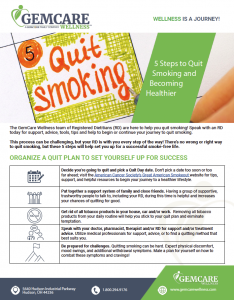Annually the American Cancer Society sponsors the Great American Smokeout on the third Thursday of November. Join thousands of people who take the first step today toward a healthier and tobacco-free life. Learn more on the ACS website.
Quitting tobacco is one of the most important things you can do to improve your health. Research shows that people who quit smoking can significantly lower their risk of other smoking-related diseases and even reduce their medical expenses (not to mention all the money they save on cigarettes!). The Registered Dietitians at GemCare Wellness have proven success in helping people quit smoking. We’ll help you educate yourself, design your quit plan, build a support system, and implement tactics for when you face challenges.
If you’re interested in working with a GemCare Wellness health coach who can help you make and implement a plan to quit smoking, review our NutraVantage packages. Get started on building a plan by clicking below to download 5 Steps to Quit Smoking:

Not ready to commit to a NutraVantage package? Contact us today to set up a consultation! Whether you’re an individual looking to improve your health or an employer focused on a healthier population, GemCare Wellness has a program to fit your needs!
Written by Jenna Adams, MFN, RD, LD & Heather Fowler, RDN, LD
Want to get a jumpstart on your health before the new year sets in? Want to learn how to manage your health during the holidays while still being able to enjoy your favorite seasonal foods? Food is a big part of the holidays, and it can be challenging to stay on track, but GemCare Wellness’ Diabetes Prevention Program (DPP) can help you learn and implement lasting lifestyle changes to improve your health and delay or prevent type 2 diabetes.
Our free-of-charge*, virtual Diabetes Prevention Program is open to anyone who has been diagnosed with prediabetes or who is at risk for developing type 2 diabetes (T2). Losing 5-7% of your body weight and getting at least 150 minutes of physical activity each week can lower your risk for developing type 2 diabetes by 58%, and if you are 60 or older, you can lower your risk by 71%.1
DPP classes provide you with knowledge and tools to navigate not only the holidays but each day successfully. You’ll learn how to incorporate the tools you learn in this program into lifelong, lasting change. Here are a few tips to get you started:
- Have a light meal or snack before a holiday event to help control your appetite.
- Bring a healthy option, such as a veggie or fruit tray.
- Hold a glass of water to stay hydrated and prevent grazing.
- Scope out the selections at family meals and prioritize your favorites, forgoing those you could do without.
- Select a moderate portion of the dessert that appeals most to you.
- Plan for fun family activities indoors or outdoors, such as going for a walk, playing board games, or having a snowball fight.
Topics we will cover throughout the year include how to eat to prevent type 2 diabetes, shop and cook, manage stress, take charge of your thoughts, and stay motivated. With weekly classes in the first sixth months of the program, you’ll find the needed support to help you navigate the holiday season. Join now, end the year strong, and start 2021 one step closer to your health and wellness goals!

*Program free of charge to participants. Funded by the Ohio Department of Health.
Sources:
- “About Prediabetes & Type 2 Diabetes.” National Diabetes Prevention Program, Centers for Disease Control and Prevention, Apr. 2019, cdc.gov/diabetes/prevention/about-prediabetes.html.
We know that making healthy choices can help us feel better and live longer but creating new habits is not always easy. The goal is to focus on you and settle on the habits you would like to make. There are many habits to consider like waking up early, focusing on the positives, workout 3 times per week and drinking more water. These are all great habits but remember habits will take time to create or change. Do not try to change too much too fast. To improve your success, focus on one goal or change at a time. As new healthy behaviors become a habit, try to add another goal that works towards the overall change you’re striving for.
Here are a few short tips to help you stay focused on making healthier lifestyle changes become part of your every day routine.
- START SIMPLE
- Don’t try to implement everything at once. Start with 1 or 2 habits you would really like to begin doing.
- Try tracking habits that you already have in place to get used to tracking. Then slowly incorporate others you would like to be more consistent with (ex: make the bed, brush teeth).
- MAKE IT DAILY
- Aim to perform tasks daily to get your mind and body used to doing them more often.
- COMMIT TO IT FOR 30 DAYS
- It takes about 3-4 weeks to make something a habit in your everyday routine. If you can make it through, it will be easier to sustain.
- SET REMINDERS
- Whether it’s a daily phone alarm, post-it note on the mirror/fridge/door, writing it on a calendar or in a planner, or using an electronic calendar, reminding ourselves to do things will allow us to make sure we get them done.
- FIND A BUDDY
- Find a friend, family member, or support group (online or in person) to go along with you and support you along the way. This will be essential for times that are challenging. Changing our habits is a journey; there will be bumps along the way!
- KNOW THE BENEFITS
- Write down the benefits that will result from making a new habit. Notice changes in energy levels, mood, or your body.
- Also know the pain and that there will be ups and downs. But remind yourself of what might happen if the change does not occur, this can be used as motivation!
- DO IT FOR YOU
- Make habits toward YOUR goals and the things that motivate YOU. Take it back to Step 1 and keep it simple. Start small and work your way up!
- REMEMBER TO STAY CONSISTENT
- The more consistent you are, the more likely the habit will stick.
Sources:
- https://www.youtube.com/watch?v=ifGg5JykgQo
- https://www.lifehack.org/articles/featured/18-tricks-to-make-new-habits-stick.html
- http://www.apa.org/helpcenter/lifestyle-changes.aspx
By: Stephanie Ineman, MS, RDN, LD
“Take care of your body. It’s the only place you have to live.”-Jim Rohn
You are diligent about scheduling your annual physical, exercise as much as you can in your busy lifestyle, and eat healthy most of the time. This is what makes a healthy individual, correct? While this is a huge step in the right direction, there are often other issues you and your doctor may not be aware of.
I often counsel individuals that tell me, “Everything must be normal, because I just saw my doctor.” I ask, did you share with them that you’re experiencing the issues you’ve shared with me? Often, the answer is no. It may have just been a quick visit to get medication refilled, or an annual wellness checkup. Your doctor is extremely knowledgeable and a huge asset to your health, but to understand which tests to order, he/she needs to hear your concerns. Just because you had bloodwork done, does not mean everything all issues were tested to ensure normal values. Labs can be very costly, so it’s important to inform your physician of anything that seems a little “off” so the appropriate test can be ordered.
Tune in to your body, and be aware of anything that seems off. Keep a journal of everything you’ve been experiencing throughout the past year. Maybe you’ve been experiencing an intermittent pain or discomfort, but it feels fine during your 30-minute appointment, so you don’t think to bring it up.
Be an advocate for yourself; Nobody knows your body better than you do. Sure, there are certain things we cannot always feel, such as high blood pressure or high blood sugar, which is why routine testing is so important. Stop dismissing little things that you keep finding excuses for, and start speaking up. Fall in love with taking care of yourself, and don’t leave it up to anyone else.


